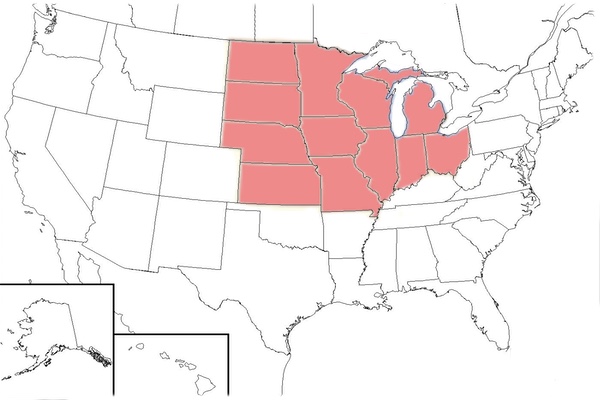Why the Midwest Is the Key to the Future of American Politics

The Midwest is the heartland of America, both in history in the past, and in the political present and future.
Ridiculed by many on the Atlantic and Pacific Coasts as the “Fly Over” states, the facts are clear that these states in the heartland pack a “wallop.” The Midwest has been a major factor in numerous elections in the past with the potential to determine the national political trend in the present and the future.
The Midwest historically has been the heritage of eleven GOP Presidents – Abraham Lincoln from Illinois; Ulysses S. Grant, Rutherford B. Hayes, James A. Garfield, William McKinley, William Howard Taft, Warren G. Harding from Ohio; Benjamin Harrison from Indiana; Herbert Hoover from Iowa; Dwight D. Eisenhower from Kansas; and Gerald Ford from Michigan. Also, two Republican Presidential nominees were from Kansas, along with Eisenhower—Alf Landon in 1936 and Bob Dole in 1996.
At the same time, Midwestern Democrats who were President include Harry Truman of Missouri and Barack Obama of Illinois, and others who were Presidential nominees include James Cox of Ohio in 1920; Adlai Stevenson II of Illinois in 1952 and 1956; Hubert Humphrey of Minnesota in 1968; George McGovern of South Dakota in 1972; and Walter Mondale of Minnesota in 1984.

We have also seen many Vice Presidents from the Midwest, including six from Indiana, two from Illinois, two from Minnesota, and one each from Kansas, Iowa, Missouri and Michigan.
It is also a reality that Ohio and Missouri have been particularly crucial “swing states.” Ohio has been very significant for the Republican Party, as every President of their party has won Ohio, and when Gerald Ford, who succeeded to the Presidency under the terms of the 25th Amendment, lost election to a full term in 1976, a major reason for the defeat was that he lost Ohio by 1/4th of 1 percent (about 11,000 votes) to Jimmy Carter.
Missouri has been with the “winner” of every Presidential election from 1904 to 2016, with only three exceptions: (1)1956 when Missouri voted by a small margin of 2/10ths of 1 percent or about 4,000 votes for Adlai Stevenson II over Dwight D. Eisenhower; (2) 2008 when Missouri voted by a similar small margin of 1/7th of 1 percent and a similar 4,000 votes for John McCain over Barack Obama; and (3) 2012, when Missouri voted by a major margin of 9.4 percent and more than 258,000 votes for Mitt Romney over Obama.
The importance of the Midwest in the Presidential Election of 2020, and in elections of Midwestern governors and state legislatures in the Midterm Elections of 2018 is self-evident. It is well known that if Hillary Clinton had won the electoral votes of Ohio (18), Michigan (16), and Wisconsin (10), a total of 44 more electoral votes, she would have won the election with 271 electoral votes. (Joe Biden might have won Ohio, Michigan, and Wisconsin in 2016.)
Potential Midwestern candidates running for the Presidency in 2020 include the following Republicans: outgoing Governor of Ohio John Kasich and Vice President Mike Pence of Indiana; and the following Democrats: Senators Amy Klobuchar of Minnesota and Sherrod Brown of Ohio. And one never knows if others might emerge over the next year, as every presidential election seems to feature surprise contenders.
Many Midwestern governorship races seem to be trending Democratic in Ohio, Illinois, Michigan, Wisconsin and Minnesota (only Minnesota presently has a Democratic governor). If Democrats prevail in November, the Midwest could transform American politics by shaping the reapportionment of seats in state legislatures and the House of Representatives after the 2020 Census figures are tabulated.
Considering how small margins in several Midwest states determined the election results in 2016, for any political observer to underrate the importance of the Midwest, particularly based on the history of that section’s impact, would be folly. So despite all of the attention that will be given to Atlantic Coast and Pacific Coast Presidential contenders, and the role of governors and senators from those sections, one can expect the Midwest to play a significant role in American politics into the long term future.